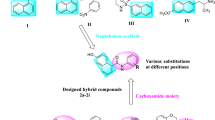Abstract
Quercetin-7-O-β-D-glucoside (1) and patuletin-7-O-β-D-glucoside (2) isolated from Achillea biebersteinii and different extracts of aerial parts of the plant were investigated for antioxidant and anticholinesterase effects. The ethyl acetate extract possessed the highest inhibitory activity against acetylcholinesterase (67.2 ± 1.32 %), whereas it showed lower inhibitory activity against butyrylcholinesterase (50.3 ± 1.03 %) as compared with neostigmine (100 %), at 200 μg/mL. Compound 2 exhibited the strongest inhibition to acetylcholinesterase and compound 1 did so to butyrylcholinesterase with IC50 values of 1.77 and 2.24 µM, respectively. Additionally, compound 1 showed the strongest antioxidant capacity. Docking simulations revealed that compounds 1 and 2 targeted both the catalytic and the peripheral active sites of acetylcholinesterase and butyrylcholinesterase with many hydrogen bond interactions. The ethyl acetate extract has the richest phenolic content (205.7 GAE/mg ext), and the best antioxidant capacity results were observed with it among the tested extracts. The mean amount of total flavonoids was 3.39 % (calculated as rutin).




Similar content being viewed by others
References
Ak T, Gulcin İ (2008) Antioxidant and radical scavenging properties of curcumin. Chem-Biol Interact 174:27–37
Baris D, Kizil M, Aytekin C, Kizil G, Yavuz M, Ceken B, Ertekin AS (2011) Antimicrobial and antioxidant activity of ethanol extract of three Hypericum and three Achillea species from Turkey. Int J Food Prop 14:339–355
Bicha S, Amrani A, Benaissa O, León F, Zama D, Brouard I, Benayache S, Bentamene A, Benayache F (2013) A flavonoid with high antioxidant effect from Centaurea acaulis L. Der Pharm Lett 5:24–30
Blois MS (1958) Antioxidant determinations by the use of a stable free radical. Nature 181:1199–1200
Bullock R (2004) Galantamine: use in Alzheimer’s disease and related disorders. Expert Rev Neurother 4:153–163
Ellman GL, Courtney KD, Andres V, Featherstone J, Featherstone RM (1961) A new and rapid colorimetric determination of acetylcholinesterase activity. Biochem Pharmacol 7:88–95
Goren N, Oksuz S, Ulubelen A (1988) A sesquiterpene lactone, sintenin from Achillea sintenisii. Phytochemistry 27:2346–2347
Guvenalp Z, Ozbek H, Yuzbasioglu M, Kuruuzum-Uz A, Demirezer LÖ (2010) Flavonoid quantification and antioxidant activities of some Pimpinella species. Rev Anal Chem 29:233–240
Hodges JR (2006) Alzheimer’s centennial legacy: origins landmarks and the current status of knowledge concerning cognitive aspects. Brain A J Neurol 129:2811–2822
Hoozesmans JJM, Veerhuis R, Rozemuller JM, Eikelenboom P (2006) Neuroinflammation and regeneration in the in the early stages of Alzheimer’s disease pathology. Int J Dev Neurosci 24:157–165
Houghton P, Howes MJ (2005) Natural products and derivatives affecting neurotransmission relevant to Alzheimer’s and Parkinson’s disease. Neurosignals 14:6–22
Huber-Morath A (1975) Achillea L. In: Davis PH (ed) Flora of Turkey and the East Aegean Islands, vol 5. Edinburgh University Press, Edinburgh, pp 224–252
Keser S, Celik S, Turkoglu S, Yilmaz O, Turkoglu I (2011) Determination of antioxidant properties of ethanol and water extracts of Achillea millefolium L. (Yarrow). Asian J Chem 23:3172–3176
Lar’kina MS, Kadyrova TV, Ermilova EV, Krasnov EA (2009) Quantitative determination of flavonoids from the aerial part of greater knapweed (Centaurea scabinosa L.). Pharm Chem J 43:14–17
Li Y, Qiao W, Yuan K (2011) Isolation and structural elucidation of chemical constituents of Mussaenda hainanensis Merr. J Med Plants Res 5:1459–1465
Mahmoud AA, Al-Shihry SS, Hegazy MEF (2012) A new epimeric sesquiterpene lactone from Achillea ligustica. Rec Nat Prod 6:21–27
Markesbery WR (1997) Oxidative stress hypothesis in Alzheimer’s disease. Free Radic Biol Med 23:134–147
Mitsuda H, Yasumoto K, Iwami K (1966) Antioxidation action of indole compounds during the autoxidation of linoleic acid. Eiyo to Shokuryo 19:210–214
Orth M, Juchelka D, Mosandl A, Czygan FC (2000) Chiral monoterpenes as taxonomically useful markers for Achillea species differentiation. Pharmazie 55:456–459
Pecetti L, Tava A, Romani M, Cecotti R, Mella M (2012) Variation in terpene and linear-chain hydrocarbon content in yarrow (Achillea millefolium L.) germplasm from the Rhaetian Alps, Italy. Chem Biodivers 9:2282–2294
Re R, Pellegrini N, Proteggente A, Pannala A, Yang M, Rice-Evans C (1999) Antioxidant activity applying an improved ABTS radical cation decolorization assay. Free Radic Biol Med 26:1231
Sezik E, Yesilada E, Honda G (2001) Traditional medicine in Turkey X. Folk medicine in Central Anatolia. J Ethnopharmacol 75:95–115
Slinkard K, Singleton VL (1977) Total phenol analyses: automation and comparison with manual methods. Am J Enology and Viticult 28:49–55
Uc EY, Rizzo M (2008) Driving and neurodegenerative diseases. Curr Neurol Neurosci 8:377–383
Ulubelen A, Oksuz S, Schuster A (1990) A sesquiterpene lactone from Achillea millefolium subsp. millefolium. Phytochemistry 29:3948–3949
Vitalini S, Beretta G, Iriti M, Orsenigo S, Basilico N, Acqua S, Lorizzi M, Fico G (2011) Phenolic compounds from Achillea millefolium L. and their bioactivity. Acta Biochim Pol 58:203–219
Yerdelen KÖ, Tosun E (2015) Synthesis, docking and biological evaluation of oxamide and fumaramide analogs as potential AChE and BuChE inhibitors. Med Chem Res 24:588–602
Zhishen J, Mengcheng T, Jianming W (1999) The determination of flavonoid contents in mulberry and their scavenging effects on superoxide radicals. Food Chem 64:555–559
Acknowledgments
This work was supported by The Foundation of Atatürk University (2013/274).
Author information
Authors and Affiliations
Corresponding author
Rights and permissions
About this article
Cite this article
Sevindik, H.G., Güvenalp, Z., Yerdelen, K.Ö. et al. Research on drug candidate anticholinesterase molecules from Achillea biebersteinii Afan. using by molecular docking and in vitro methods. Med Chem Res 24, 3794–3802 (2015). https://doi.org/10.1007/s00044-015-1423-8
Received:
Accepted:
Published:
Issue Date:
DOI: https://doi.org/10.1007/s00044-015-1423-8




